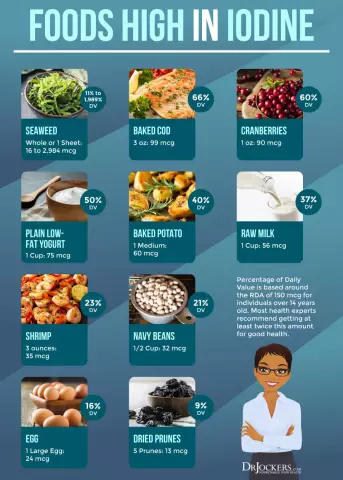- Author Rachel Wainwright [email protected].
- Public 2023-12-15 07:39.
- Last modified 2025-11-02 20:14.
Vitamin B15
Vitamin B15 (pangamic acid) - was first isolated in 1951 by Japanese scientists in beef liver, and in 1951 it was synthesized in an American laboratory from the kernels of apricot kernels. Vitamin B15 is readily soluble in water, destroyed by light and high temperatures. Since the lack of pangamic acid does not lead to metabolic disorders in the body, in fact, vitamin B15 is a physiologically active vitamin-like substance.

Vitamin B15 is necessary to normalize fat metabolism, lower cholesterol levels, stimulate protein synthesis (increases the content of creatine phosphate in muscle tissues, and glycogen in the liver), enhance the use of oxygen by tissues in redox processes, thereby increasing the life of cells, promotes vasodilation and inhibits inflammatory processes.
Due to these properties of pangamic acid, vitamin B 15 is a powerful antioxidant. The anti-toxic effect of vitamin B15 helps to improve the functioning of the liver and adrenal glands, to eliminate toxins and decay products of drugs and alcohol from the body. By reducing alcohol intoxication, it reduces the likelihood of a hangover and the risk of alcohol dependence.
The presence of 1-2 mg of pangamic acid in the daily diet will reduce muscle fatigue and increase efficiency, reduce the risk of fatty liver, and improve heart function.
Where is vitamin B15 found
The high content of pangamic (Greek: pan - everywhere, gamy - seed) acid in plant seeds, as evidenced by its name. In a certain amount, vitamin B15 in the body is synthesized directly by the microflora of the gastrointestinal tract.
Plant Sources: Vitamin B15 is found in stone fruit kernels, nuts, melon, watermelon, pumpkin, brown rice, rice bran, brewer's yeast.
Animal products - animal liver and blood contain significant amounts of pangamic acid.
Vitamin B15: deficiency and excess
Lack of vitamin B 15 in the diet can cause:
- Increased fatigue;
- Decreased ability to work;
- Increased irritability;
- Nervous disorders;
- Disorders in the endocrine system;
- Oxygen deficiency in organs and tissues;
- Complications of the cardiovascular system;
- Premature aging of the body as a whole.
When taken into the body up to 2 mg of vitamin B15 per day is enough to ensure the normal functioning of all systems and organs. In the case of increased loads - sports, hard physical work, some diseases, the amount of foods containing vitamin B15 in the diet should be significantly increased, the lack of which will adversely affect health.
The modern pharmaceutical industry offers a wide range of preparations containing vitamin B15 in the form of pangamic acid salts - calcium pangamate. For the treatment of some diseases, the daily requirement of the body for vitamin B 15 can increase to 50-100 mg or more, but only the attending physician should prescribe such therapy.
Excess or overdose of pangamic acid can cause headaches, irritability, drowsiness, weakness, tachycardia, and heart failure.
Vitamin B15, interactions with other substances
Salts of pangamic acid interact with other substances in the body in the following way:
- They dissolve well in water;
- Promote the binding and elimination of chlorine-containing compounds;
- When used together with aspirin, they reduce its side effects, protecting the stomach and adrenal glands;
- In case of an overdose with sulfonamides and tetracyclines, they contribute to a faster cleansing and recovery of the body;
- Joint intake with vitamins A and E enhances the effect of B15 on metabolism;
- Combinations of vitamins B15 with B12 are required for the normal course of certain biochemical reactions in the cells of the body.

Indications for the use of vitamin B15
The use of pangamic acid is recommended in the treatment of the following diseases:
- Atherosclerosis of various forms;
- Pneumosclerosis;
- Sclerosis of the vessels of the brain;
- Bronchial asthma;
- Pulmonary emphysema;
- Chronic hepatitis;
- The initial stage of liver cirrhosis;
- Chronic alcohol intoxication;
- Itchy dermatoses;
- Rheumatic diseases;
- Chronic coronary insufficiency.
Vitamin B15 is prescribed in combination with sulfonamides, corticosteroids and anti-tuberculosis drugs for their better tolerance.
Found a mistake in the text? Select it and press Ctrl + Enter.






